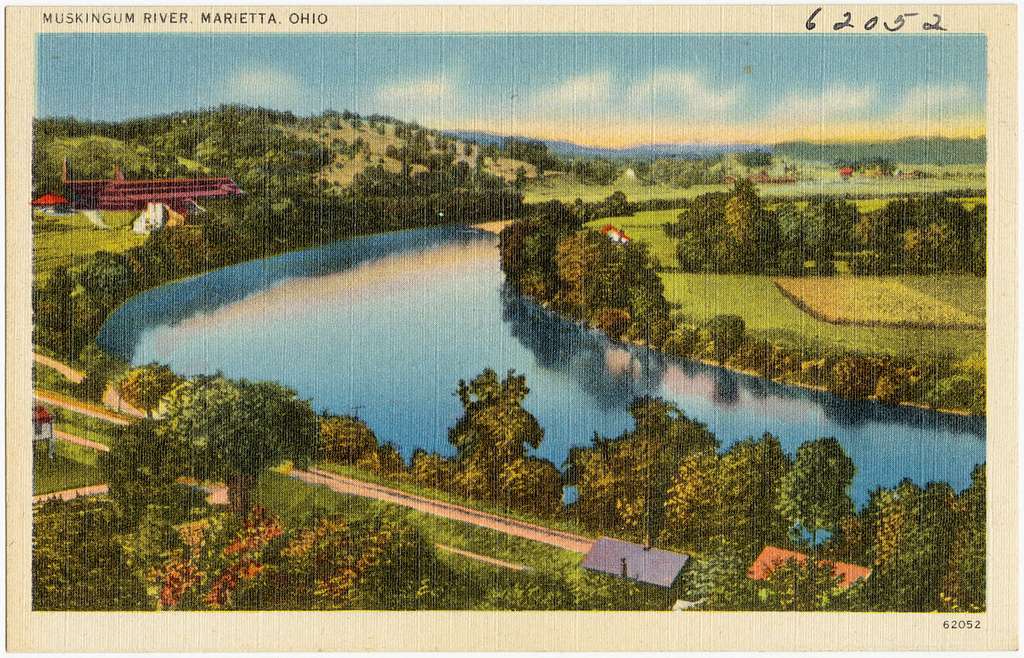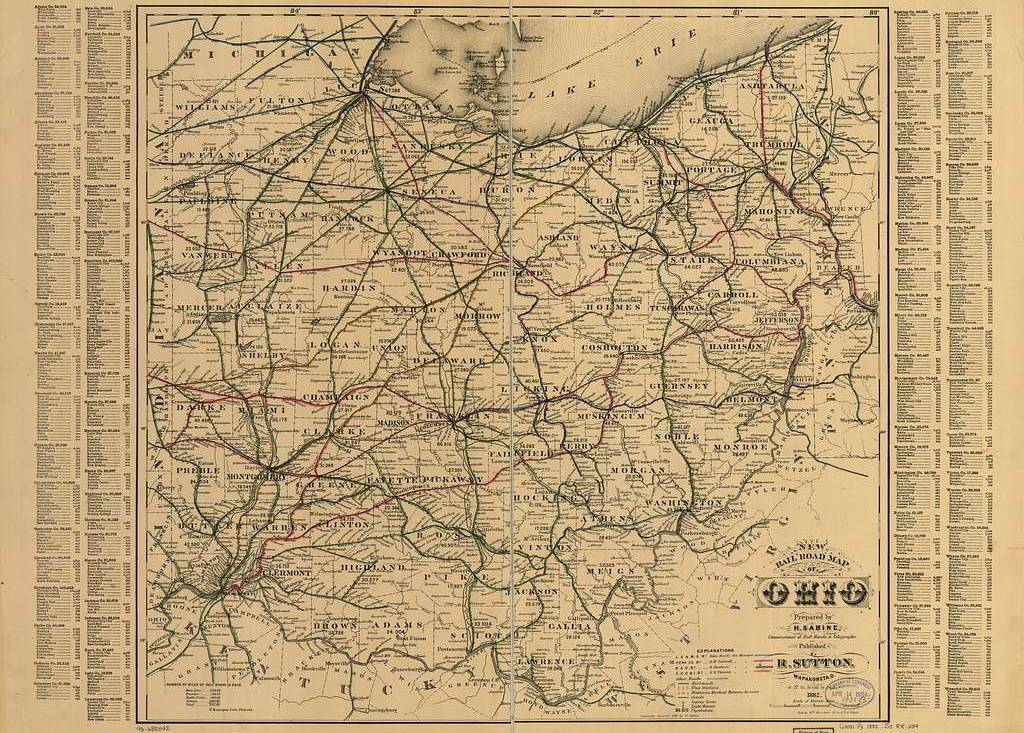The city of Ashtabula, Ohio is a lovely place along Lake Erie, less than an hour’s drive northeast of Cleveland. It’s also the place where one of the more horrific accidents in history occurred, and part of the reason why I almost always hold my breath while crossing a bridge in this state.
Very near what is today the corner of Cederquist Park, just as a Pacific Express train was crossing the Ashtabula River, the bridge collapsed, sending the train as well as everyone and everything on it into the river below. Ninety-two people lost their lives, we think, while sixty-four were seriously injured.
The Ashtabula River Railroad Disaster
On December 29, 1876, the Pacific Express train left Buffalo, New York at about two o’clock in the afternoon, which was just over an hour behind schedule. Two days earlier, northern Ohio and much of Pennsylvania and New York had been hit by a rather notorious blizzard, leaving over twenty inches of snow on the ground in most places. High winds didn’t help much, considering they had left six foot high snow drifts along the railroad tracks in some places.
At 5:01PM the train left Erie, Pennsylvania, a few further minutes behind schedule. Due to the treacherous conditions, it needed two locomotives to haul two baggage cars, two passenger cars, two express coaches, three sleeper cars, one drawing room car and a smoking car. All in all, there were somewhere between 150-200 souls on board, not including roughly 20 crew.
By the time the train reached Ashtabula, it was nearly two hours behind schedule. When it reached the bridge in question, they were forced to cut the steam, which would have allowed the train to glide into the station. Visibility was beyond poor, no more than a train car length or two.
Just as the locomotive was reaching the western abatement, the train was traveling at approximately fifteen miles per hour. Engineer Daniel McGuire heard a large crack and felt the train jolt downward. Knowing what was likely happening, he thrust the throttle to maximum and the train lunged forward. The connection between his loxomorive and the one behind it then uncoupled as the rest of the cars fell as the bridge collapsed. McGuire brought his locomotive to a halt about one hundred yards down the track and immediately began sounding his whistle.
The remaining cars, still linked, began to fall. Some cars, such as the smoking car, decoupled and was violently thrown on top of the passenger car ahead of it, which is likely what killed all of the people who had been in that one. Other cars were more slowly dragged into ravine, resulting in less severe injuries.
There was some initial confusion over where the fire started. Some survivor reports believed the fires started instantly while others said there was some delay. Some reports said that the fire started in the middle of the train then worked outward, while others believed it to start at one or both ends and burnt toward the middle. Now it is beleived that the coal and kerosine system used to heat the passenger cars was the most likely culprit.
Rescuers had a hard time reaching the train as the only way to access the riverbanks was via a set of steep stairs that were already covered in ice and snow. This inability for anyone to reach the wreckage in a timely manner also contributed to the number of people who lost their lives that day. Among the casualties, some drowned in the icy waters, others died from impact wounds, while others from smoke inhalation or burns.
Sadly, we’ll never know how many people exactly lost their lives in that derailment. The official number currently stands at 92, although there is no way of knowing for certain. We do not know, for example, how many people were effectively cremated in the fires. For some victims, only a body part was found, such as a hand or foot – the further remains either washed down the river or burned in the fires. Many of the victims were never officially identified.
One victim that was identified was American composer Philip Paul Bliss.
While rescuers were still busy trying to rescue the living or recover what human remains they could, there were others on site with more nefarious intentions – sifting through the wreckage looking for valuables, even going as far to take wallets and jewelry off the corpses making later identification all the more difficult.
Beginning at sunrise the following morning, local resident Fred W. Blakeslee appeared on the scene and began taking a lot of pictures. Some were published in various sources while all were also made available to anyone investigating the disaster. These have been included in most official documentation.
What Went Wrong?
There were several groups of people who began investigating the cause of the bridge collapse.
The Coroner’s Jury
Being that the city of Ashtabula did not have a coroner, they instead summoned a group of six local men to serve as a coroner’s jury and were overseen by Justice of the Peace Edward W. Richards.
They deremined a number of things:
- The bridge was poorly designed, in that some of its parts were not designed to withstand heavy loads.
- The bridge was poorly constructed. They determined that the various parts of the bridge all acted independantly from each other, rather than acting together to work as a solid unit.
- The bridge was poorly inspected. Had inspectors done their jobs properly, they would have likely noticed several defects that could have prevented this disaster.
- The railroad had been required by law to utilize self-extinguishing stoves and it had failed to do so.
- The people who were among the first to arrive at the scene neglected to attempt to put out the fires, so the coroner’s jury determinted that some fault lay with them, too.
The Ohio Grand Assembly
On January 1, 1877, The Ohio Grand Assembly appointed a team to investigate the causes of the accident. After a legnthy investigation they dertermined a few things:
- The bridge design was at fault. No part of the bridge was designed to withstand lateral buckling.
- There were errors in construction, most notably the braces were not built to act in unison.
- The required inspection of the bridge would have, if performed correctly, noticed several flaws that could have been dealt with before disaster struck.
Most notably they determined that the construction materials were not at fault. They also discounted the theory that the second locomotive caused the collapse by applying the air brakes, a theory that had been passed around for some time without any actual evidence supporting it.
The MacDonald Investigation
A third inquiry was made by an independant civil engineer named Charles MacDonald by the American Society of Civil Engineers (ASCE). He found three faults:
- Proper bridge inspections had not been properly performed, noting that some of the (so-called) inspectors were barely trained. This was a systematic problem, he said, not an issue with just the railroad companies whose jobs it was to inspect that particular bridge.
- The railroad industry, as a whole, massively misunderstood the strength of iron, of which the bridge had been constructed of.
- He also determined that at least one lug used in the construction of the bridge had flaws from when it was made. (This is an essential plate with a hole in it that was used in bridge construction.)
MacDonald believed that the bridge had ultimately collapsed because a lug used in the top (and west) section of the bridge had been filed too thinly, causing that section of the bridge to fail, and take the rest out with it.
It is important to note here that while the three bodies came up with somewhat different conclusions, there were a number of consistencies between them, hte most glaring being that had the bridge been correctly inspected by people who knew what they were doing, none of this would have happened.
The Railroad That Investigated Itself
The LS&MS president Amasa Stone had other ideas. He categorically dismissed the findings from those three investigative units. Instead, he denied that neither his company nor the construction of the bridge were to blame.
Who was responsible, according to him? Well …
First, he tried to claim that one of the two locomotives had somehow derailed while crossing the bridge, then fell and took the bridge out with it. Then, he kind of backtracked a bit and said that a rail had gotten loose, which caused the derailment.
If that wasn’t enough, he also suggested that a mini tornado had taken the bridge out.
And that, folks, is why we shouldn’t allow companies to investigate themselves.
What Really Caused The Bridge to Fail? A Modern Look
This section of the story really ought to be written by an engineer, or some other form of construction professional – but since there doesn’t seem to be one in the room at the moment, I guess I’ll just have to do the best that I can.
First off, Iron was used to make the bridge and today we know that isn’t nearly as strong as they thought it was back then. The iron, at the time of the collapse, had been showing signs of fatigue. Frankly, if the metal that was used to hold the bridge together wasn’t able to work for an extended period, it was just a matter of time before the bridge fails.
Secondly, the weather played a role as well, although perhaps not in the way you’d expect. It wasn’t the snow that caused problems – it was the temperatures outside.
When iron gets really, really hot, it’s bendable, moldable, and fairly easy to shape into things like candlesticks or butter knives. Once it cools a bit, it becomes a lot more rigid. Those effects continue if the metal gets even colder, like … during a lengthy period of sub-freezing temperatures. Cracks can form, or existing ones can get worse.
Finally, the systematic failure of the industry to properly inspect the bridges, as they were required to do by law, was largely responsible for the collapse. Had the bridge been inspected by people who knew what they were doing, it had enough signs of imminent failure that the bridge would have either been fixed, or redesigned, before the loss of human life.
How The Ashtabula Bridge Collapse Changed Things
Shortly after the bridge collapsed, Ohio legislators drafted a bill that would create a code of standards bridge builders would be required to follow, including oversight from civil engineers and require frequent inspections from trained engineers. This bill, however, never became law.
The citizens of Ashtabula, in light of the bridge collapse, had some issues of their own. Namely, they questioned whether or not their city had sufficient medical facilities to handle emergencies like this – so they set up a fund to build an emergency care clinic that opened in 1882 and a general hospital that opened 1904.
Following Ashtabula, iron would no longer be used in bridge construction and railroads began replacing the flammable wood and coal eating systems with steam-based systems that wouldn’t cause fires.
In 1887, one part of the new Interstate Commerce Act would allow the federal government to investigate train derailments and fatal railroad accidents.




Pingback: Ashtabula Horror Ghosts & Treasures - The Ohio Project